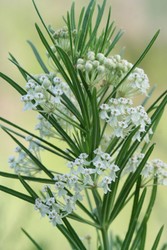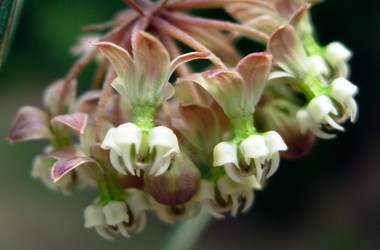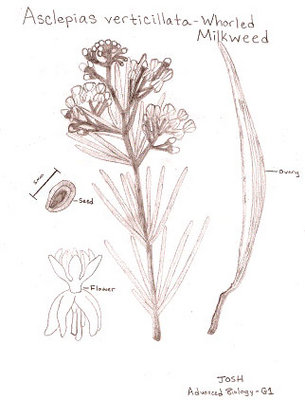Lakota name: waĥpé tiŋ'psila (means turnip leaf)
 Listen to Lakota Plant Name: waĥpé tiŋ'psila
Listen to Lakota Plant Name: waĥpé tiŋ'psila
Scientific name: Asclepias verticillata
Common name: Whorled Milkweed
Medicinal use: Lakota mothers would use this plant when they didn't have any milk. Some Native American tribes used it to treat snake bites and nose or throat ailments.
Secondary plant compounds: The plant produces cardiac glycocides. Cardiac glycosides can be used as a type of drug to treat congestive heart failure and/or cardiac arrhythmia. Found as a secondary metabolite in a few different plants and animals, some of these compounds are used as a poison for hunting in different countries. The monarch butterfly is one of the main animals that benefit from Asclepias verticillata. When a monarch caterpillar eats the milkweed it is able to absorb and sequester the poison that would harm other animals without harming itself. When a predator eats one of these butterflies, it is forced to throw it back up, causing the butterfly to die, but the predator remembers the trademark bright orange color of the monarch. This ends up helping the whole population because the predator won't try to eat another one now. There is even another species of butterfly that doesn't obtain this poison at all, but mimics the monarch in appearance so as to also better avoid predators.


Molecular structure of a cardiac glycoside. © 2008 1sagebrush8
Description: Poisonous, known to be invasive and/or weedy, 1 to 3 ft. tall. It is a graceful plant that often forms colonies with a shallow root system. Milk and juice are found in the stem that also holds leaves with five to ten flowers made of less than one-inch clusters of umbels. The fruit is in a pod of about 3 inches long and half an inch wide. Very narrow, two-inch leaves in whorls of two to four are distributed along the full length of the stem.



Asclepias verticillata. Left: leaves and flowers © 2007 Brian Peterson. Right: close-up of flowers © 2005 Josh.
Habitat: Located in dry prairie soils, open sandy woods, rocky hillsides, and it is common on road sides and glades. Open areas, lightly or moderately grazed prairies and thickets are other typical locations for this plant.
Similar Species: The Carolina milkweed (Asclepias cinerea) has white to light purple flowers with thin opposite leaves. It can be found on the Coastal Plain in Georgia, South Carolina, and northern Florida.
Flowering/Fruiting Period: Flowers from June-Aug. or Sept.
U.S. Distribution: Florida up to New Hampshire, all the way west through Arizona up through Montana, not including Idaho, Utah, or Colorado.
South Dakota Distribution: Common all over the state in roadsides, praires, and waste places.




 Go to quick links
Go to quick search
Go to navigation for this section of the ToL site
Go to detailed links for the ToL site
Go to quick links
Go to quick search
Go to navigation for this section of the ToL site
Go to detailed links for the ToL site